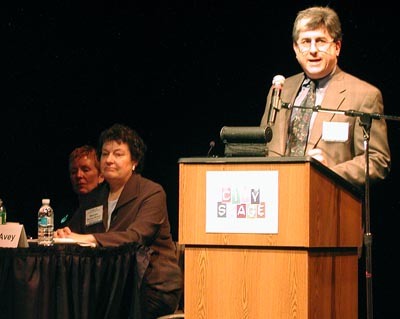 At the ULI panel’s presentation last month, Ray Kuniansky, Chief Operating Officer for the Atlanta Neighborhood Development Partnership, spoke about how to “strengthen the present” and “plan for the future.” He began by praising Springfield’s assets: it’s a compact city with abundant major institutions, beautiful buildings, and many open spaces with greenery and water—making “a beautiful city.”
At the ULI panel’s presentation last month, Ray Kuniansky, Chief Operating Officer for the Atlanta Neighborhood Development Partnership, spoke about how to “strengthen the present” and “plan for the future.” He began by praising Springfield’s assets: it’s a compact city with abundant major institutions, beautiful buildings, and many open spaces with greenery and water—making “a beautiful city.”
“You guys have everything,” Kuniansky said. “You’ve got parks, you’ve got water features, you’ve got all these neighborhoods that are within a 15-minute drive of your downtown central area. You’ve got an incredibly diverse and wonderful housing stock. You’ve got architecturally significant buildings. It’s a very compact city here; you can walk just about anywhere in the downtown area.”

Kuniansky went on to describe Springfield neighborhood strategies: conservation, transition, and intervention.
“What’s a conservation area mean? You’ve got high homeownership, with good retail and good services. The strategies would be to enhance them with capital improvements and beautification. We think you’re going to have to work on housing renovation. Don’t lose the stock of beautiful homes that you have here. There’s a reason you were once known as the City of Homes.”

The second strategy Kuniansky outlined is for neighborhoods in transition. “These are areas that are on the edge,” Kuniansky said. “They can go up; they can go down. What do you need to do about that? You’ve got to provide investments in projects that will stabilize these areas. Focus on crime prevention, and retain existing services, while trying to attract new ones.”

Next Kunianksy turned to neighborhoods that are in need of the equivalent of cardio-pulmonary resuscitation, calling for an intervention strategy. “These are areas that typically have low homeownership rates, high crime rates, and that overall creates a lowering valuation environment,” Kuniansky said.

“What do you do in these areas? They need major investment. They need catalytic projects. They need extra attention from code enforcement, and additional police patrols. All of these things will help you to begin to stabilize these areas, and give them the opportunity to move up as well.”
Listen to Kuniansky’s three-minute presentation on neighborhood strategies (mp4, 1.3 MB)
Kuniansky turned last to the urban core, which he defined as “the center of employment, culture, government, and unique living spaces.” He continued, “A vital urban core is critical to the long-term health and stability of both the city, including all of the neighborhoods, as well as the region. The downtown here is compact, it’s walkable, it’s accessible—it’s amazing how accessible this downtown is—and it has an incredible sense of history. Capitalize on all of these things. Don’t lose by ignoring what you have.”


